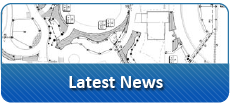One of the biggest Landtech ‘values’ is when we work with landscape architects and develop an estimate of what the water needs will be based on their landscape design. With water prices and water scarcity both going up, we are often asked to reduce water use for irrigation purposes. Water harvesting, or collecting rainwater to be used for irrigation by directing it from the roof into a cistern, is a good method for reducing reliance on municipal water supplies. The following is a description of our process for predicting water use for irrigation to help you understand what goes into creating the most water efficient irrigation system possible.
Our process begins with what we call “scoping”, which is an exercise that enables us to come up with a recommendation for the optimal size of the cistern needed for water harvesting. This is important to determine because cisterns are the most expensive component of a water harvesting system. You need the cistern to be large enough to collect the rain expected to fall, but you don’t want it to be so big that is will never be full, resulting in money wasted. So how do you know what size cistern is right for a given site?
Landtech has a model (below) that helps estimate water use during the peak month of July. Once we know the expected amount of water that will be needed, we give the data to our partner, Wahaso who are experts at water catchment and reuse. Wahaso uses the information to discern the optimal size for the cistern, or water catchment system, based on how much water the site can expect to harvest according the average amounts of rainfall, as well as the area of the roof/surfaces that collect the rainwater.

Here is an explanation of the above model:
We begin by grouping the site into categories based on the water needs of the plants and turfgrass. Group A represents the acreage of turfgrass and lawn areas. We assign each group a weight based on how high the needs are for watering the area. Group A is weighted at 100% meaning it has the highest needs of all groups, and therefore placed at the top of list for watering priority. Group B is the next most demanding group, representing the amount of acres for the highly visible/more-public areas. This is weighted at 70% because it can do fine with a little stress, whereas Group A will not and, therefore, needs to receive 100% of the water required. Group C is the acreage of the plant beds, which we deem moderately important, weighting them at 65%. Last, is Group D representing the areas that will require temporary irrigation to enable newly planted trees or plants to get established. This group is given a weight of 60%.
The next step is determining the amount of rainfall (RF) to be expected, as well as the amount of rainfall that will be effective (ER), due to slope, plant cover, soils, etc. This reduction is necessary because there will never be 100% of the rain that actually percolates into the ground during/after a rain event.
Then, we must consider the evapotranspiration rate (ET) for the area, which refers to the amount of water that evaporates before it can be absorbed + the amount of moisture that transpires from the plants. We then subtract the evapotranspiration amount from the effective rainfall amount to determine the amount of supplemental water required for each group, according to their weighted needs. Next, an efficiency factor is applied (by Group) to develop an estimated application amount.
Once we have this amount of water-inches required, we multiply that by the number of acres for each group to summarize the number of gallons of water the site will need for irrigation per month. We then compare that to how much rainfall will be able to be captured. This reveals the optimal cistern size for the specific site.
If we find that the landscape plan has the need for more water than what we can capture, we then try to work with the team to find ways to tweak the design so that it will demand less water. For example, by having a larger portion of the site landscaped with hearty plants that use only half the amount of water than turfgrass does, we can cut down on the overall water needs for the site. Another option would be to increase the ‘collection’ area in order to capture more water.
There are many factors to include in order to accurately estimate how much water a site will require for irrigation. If done correctly, it will uncover opportunities for reducing the irrigation needs for a particular site. The key is being able to understand the data and the options available to create the most efficient and effective irrigation system possible.



